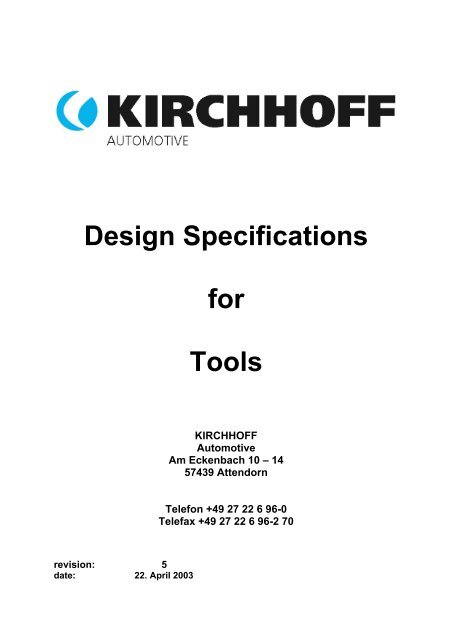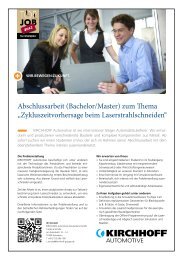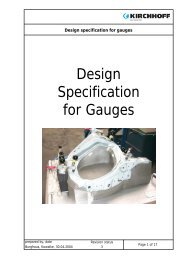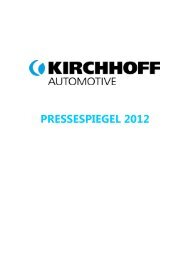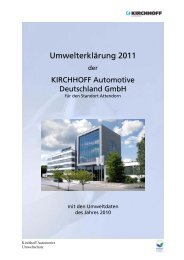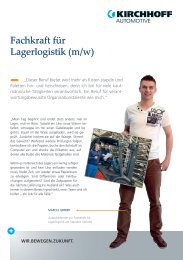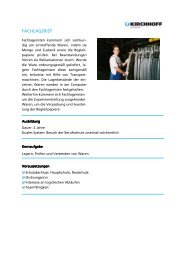Design Specifications for Tools - KIRCHHOFF Automotive
Design Specifications for Tools - KIRCHHOFF Automotive
Design Specifications for Tools - KIRCHHOFF Automotive
You also want an ePaper? Increase the reach of your titles
YUMPU automatically turns print PDFs into web optimized ePapers that Google loves.
<strong>Design</strong> <strong>Specifications</strong><strong>for</strong><strong>Tools</strong><strong>KIRCHHOFF</strong><strong>Automotive</strong>Am Eckenbach 10 – 1457439 AttendornTelefon +49 27 22 6 96-0Telefax +49 27 22 6 96-2 70revision: 5date: 22. April 2003
<strong>Design</strong> specifications Update 22.04.03pageAttach. page no.01 General 302 Scope of supply „tool design“ 3 2.1-.203 Material selection 504 Tool design 505 Tool guidance 706 Cutting elements in the lower tool part 807 Cutting elements in the upper tool part 908 Mould slides within the tool 1109 Pilot / Coarse inserts 1210 Spring elements / gas compression spring 1311 Tool distances and spring relief 14 11.1-.212 Tool centring 14 12.113 Tool tension/set 14 13.114 Tool locking/securing 15 14.1-.2-.3-.4-.515 Pneumatics 1516 Parts marking 16 16.1-.2-.3-.4-.5-.6-.717 Tool marking 1618 Scrap disposal and parts transport 17 18.1-.2-.319 Coating of the active parts and hardness details 1720 Painting 1821 <strong>Design</strong> of weld projections 1922 Tool transport and weights 21 22.1-2.-3.-4.-5.-6.-7.-823 Delivery of tools 2124 Gripper systems 2225 Material use of the parts 2226 Supplier of standard parts 22 26.1-.2-.3-.4-.5-.627 Warranty terms + conditions 232
01. GeneralThese design instructions are in addition to the written tool order an integralpart of all future tool orders.The details in the protocol of a possible start conversation have to berespected during the design and the manufacturing of the toolAll changes or deviations have to be allowed by Kirchhoff <strong>Automotive</strong>(Abteilung Werkzeugeinkauf). These has to happen in writing.<strong>Tools</strong> must correspond to current standards and rules <strong>for</strong> accident prevention,especially of the German accident prevention and insurance association(Eisen und Stahl-Berufsgenossenschaft).Drawings sent to Kirchhoff <strong>Automotive</strong> <strong>for</strong> acceptance of the design must bein the scale of 1:1 or at very large tools in the scale of 1:2.02. Scope of supply „tool design“Construction drawings are mandatory. The tool construction must be sent toKirchhoff <strong>Automotive</strong> <strong>for</strong> acceptance. An acceptance does not release fromthe responsibility <strong>for</strong> the functioning of the tools and <strong>for</strong> the accuracy of thepart dimensions. Your constructions will be discussed with us be<strong>for</strong>e toolmanufacturing. You will receive the press-charts, the Kichhoff-Kutsch normand the written manufacturing order to define the requirements.You must provide the data of the assemblies, part drawings, 3D/Data(surfaces), 2D erosion data, plunger-measurements on a CD with one copyFor the warehousing of spare parts it must be guaranteed that <strong>for</strong> the sparepart manufacturing the 3D data (surfaces) are supplied according to positionnumbers.Format of data:Catia V4 modellCatiaV5 R9igsstep / dwg / dxf / ( 2D)The data off the single components must be complete regarding:- fastening- positioning- brak-throughs(lateral sides of a punched hole- weight ( see attachment, page 2.1 )3
A separate BOM <strong>for</strong> all standard parts has to be administered which statessupplier and order number( see attachment, page 2.2 )Data exchange – tool constructionThe data records must include the following in<strong>for</strong>mation at the naming:1. KA -Nr. If necessary with insert no. and part-no.2. Identification, what kind of records:WZ = tool dataE = erosion dataF = milling dataB = burning dataP = product data3. dateThe tool construction must include the following data shown separately:• assembly• cuts with position number• single parts with position number and material details• top view• burning data• erosion data• milling data with NC Data sheets, offset – designations and milling point o<strong>for</strong>igin in XYZ direction, the workpiece outlines must be included in themilling data XYZ-direction• Bill of materialsThe views must completely be with measurementsThe tool data have to be denoted according the following keyKA6100_02_T1_E_100802.igsFile <strong>for</strong>matDateErosion dataPart 1Insert 2KA-No.4
03. Material selectionWhen the written tool order does not contain details <strong>for</strong> the material selction,these will be defined during the tool start conversation.materialapplication areaSt 52GG 25GGG 70Lbat/shelvecasted superstructure elementsblank holder pathsPunch plates, tool superstructures outsidefrom the active parts1.2363 Cutter bar trimming at 3-D parts sheetthickness up to 0,8mmCutting punches and blanking dies, , drawingpunches, bending punches, die plates1.2382 Active parts from casted steel1.2436 Letter stamps1.2842 backing plates, stripper platesRex M4when discussed04. Tool designThreaded joints of tool components should be executed in a way that allowsthe easy exchange or rework (polishing, grinding) of wearing parts at the setuptool.The lower tool part must be screwed from the top and the upper part from thebottom5
The tools must be designed to fit the press listed in the order. This isespecially important <strong>for</strong> the clamping fixtures, the height where the strip comesin, the scrap disposal by the machine table and the positioning of table andram.Special attention has to be paid to a stable tool design that has to fit to pressand hole <strong>for</strong> the parts falling through in the machine table. At castedsuperstructures there have to be at least 2 ribs per side in longitudinaldirectionThe tools have to be deigned to produce the required quantities without aproblem. For later appearing hidden defects the tool manufacturer will carry allcosts.Cylinder-pins (dowel) <strong>for</strong> positioning of parts must be used as standard partswith inside thread. Pin holes must be drilled completely through, blind holesare to be avoided. All pins in the upper tool parts have to be secured againstfalling out by using pin locks of the company Sankyo (Spring Plug) or by usingcountersunk head screws.The complete tool structure has to be pinned (dowel) continuously. <strong>Tools</strong>drawers have to be locked in place, where a disassembly of the press muststill be possible.Stripper plates in the upper tool part are to be screwed together from thebottom, they should have circumferential space of 0,2 mm in the area of theplunger.The complete tool design is to be pinned (dowel) and screwed so that awrong set up is not possible, marking of the part position is not sufficientAll punches have to be guided by punch plates. Plate guidance cuts must notbe used. Welds to cutting plates, punches and in the area of the <strong>for</strong>ming arenot allowedAt progression tools with more than 400 ton <strong>for</strong>ce the minimum screw size of<strong>for</strong> socket screws should not go under M16. Every time two securing boltsmust be used. If plastic or spiral springs are used, these have to be boltedtogether as spring packages A number of holding bolts should not go under 4+ 2.At progression tools it must be guaranteed that the stripper plate is not able totilt during the cutting start. This shall happen by distance pieces that are 0,2mm lower that the top edge of the stripes on which the stripper plate will bearon.6
Bending against the stripper will just be accepted in exemption afterdiscussion with Kirchhoff <strong>Automotive</strong>. The exact construction will then bediscussed in every single case.Blankholders must be displaced by impact pieces. These should be able to bedemounted easily. They should be adjusted to the appearing <strong>for</strong>ces to thehighest possible degree.The tools must guarantee - by the process sequence and by suitable coatingsthatparts can be processed without using oil.Ejector pins have to be placed in the tool’s upper part, in the bending punch aswell as at the separating of the part in the stripper plate.Heel punches at bending punches have to be supported by a fitting key (heelblock), heel block of non-ferrous heavy metal with a solid lubricant. Platethickness at least 10 mm. Bolting joints by countersunk screws should beavoided to create a surface as large as possible.05. Tool guidancesTo secure the tool against torsion of upper against lower part one pillar has tobe placed unsymmetrical at a 4 pillar guidance, with a 2 pillar guidance thediameters of the pillars have to be different.If a block guiding is used, the torsion must be avoided by selecting differentsizes of the blocks.If spring relief pieces are used within the tool, it must be ensured, that theguiding pillar will dip at least 1,5 x D into the guide bush to guarantee a propercentring at the tool fixture of the upper part.Guiding pillars and bushes are to be used according DIN/ISO as follows- Guide pillars DIN 9825 / ISO 9182-2 without a collar- Guide pillars DIN 9825 / ISO 9182-5 with collar- Guide Bushes DIN 9834 / ISO 9448 with collarClosed Pillar guidances must have exhaust hole of at least 10 mm diameterPart lifter or strip lifter with a stroke of more than 40 mm have to be guided bypillars with ball-cages or spring-bolts of made by Sankyo.- Guide bushes DIN 9831 / ISO 9448 –3 with ball cage7
06. Cutting elements in the lower tool partThe blanking die and hole bush thickness must not be smaller that 32 mm.The backing plates <strong>for</strong> the hole bushes must be worked into the mountingplate.Hole bushings always have to be executed as standard bushes with collar.The approved suppliers must purchase them.Where it is technically not possible to use these bushes it must be ensured,that the hole bushes will stay in their seat, e.g. by a fit-in keyThe standard dimensions must not be changed.Hole bushes with elongated hole respectively hole bushes, used in contourshapes, must in principle be secured against twisting (by a cylindric pin orspline. The locking area to prevent twisting must be executed parallely to thelong side (see sketch)At material thicknesses of more than 1 mm, backing plates <strong>for</strong> the hole bushesmust be used.Hole bushes without collar must be supported by backing plates, too.If the die plate has different levels, inserts have to be to facilitate sharpening.So one height can be reworked without need to do all heightsClearances in die plates, e.g. <strong>for</strong> beads, must have a depth of at least 8 mm,to prevent an early rework of the exposure, at the follow up of the die plate.Die plates <strong>for</strong> the outer trimming of parts with 3D contours should be executedwithout cone shapes, if possible, to allow manual rework. Then the trimmingcontour must be opened to the outside do allow a decent scrap disposal.Die plate inserts in contours have to be provided with additional threads, thethreads should preferable be placed in the screw holes.8
07. Cutting elements in the upper tool partCutting punches must in principle be provided with ejector-pins – wherepossible - .(not as rubber inserts or ball thread pins).Fastening thread(Befestigungsgewinde)Threaded pin(Gewindestift)Spring(Feder)Ejector pin (Abdruckstift)A maximum length off the cutting punch of 100 mm + back guidance must notbe exceeded, except <strong>for</strong> Kirchhoff <strong>Automotive</strong> allowed it.All cutting punches have to be fixed through the top plate with cylinder headbolts DIN 912, so that the head lies on the hardened backing plate. Thethickness of the backing plate must be at least 10 mm. All screw connectionsof the punch must be accessible through the top plate.When there is the possibility that - at the cutting - a lateral shear occurs (e.g.at the cutting of a strip) the cutting punch must be provided with a heel block.Reducing Cutting <strong>for</strong>ce by different lengths of the cutting punches.Hole- and cutting-punch must dip 5 mm into the material, also after angledpolish!When pilots are located in the blanking out punches, in their area ejector pinshave to be located.9
Cutting punches with shaped contours must not be discharged from the shaftto the edge. Sunk-eroded punches should just be used as exemptions.Above the cutting punches a hardened backing plate must be used.Cutting punches that cannot be screw fastened because of their size mustsecure against falling out by pins without an inside thread or by balls. Upsetheads will not be accepted.Cutting punches must be fixed by a punching plate, which must have athickness off at least 35 mm.piercing punchesAll hole punches must in principle be equipped with ejector pins. At the shankhole punches must be relieved towards the cutting edge. A maximum length of100 mm must not be exceeded, unless otherwise agreed by Kirchhoff.Standard Piercing punches must exclusively be used, which must not bereworked. The standard parts must be purchased as a complete part at theapproved suppliers.Piercing punches < 4 mm must be guided by adaptive sleeves as specified inVDI 3374. The shape off the head must be executed with a collar. (see Fibro:adaptive sleeves with ejector pin (Einsatzhülsen mit Druckstift), Form 233).If the tool is equipped with various piercing punches, they must have differentshaft diameters to avoid confusion. If this is not possible, <strong>for</strong> each hole thepiercing punch diameter with the according number of punches must belabelled in the punching plate.Piercing punches must be secured in a punching plate with a minimumthickness of 35 mm. The punch must be able to be changed without reworkingthe shape of the head.Only piercing punches of minimum HSS quality are admissible.A hardened backing plate is to be used above the piercing punch.The design must ensure that screwed connections of tool components do notimpair easy exchange of piercing punches; this can <strong>for</strong> example be achievedby providing separate punch plates, piercing punches that are accessible fromthe upper tool part through hard plates and ejector pins.Slotted hole punches must be secured in the punch plate by a cylindrical pin(dowel). The pin should not have an internal thread to prevent twisting. The10
locking area to prevent twisting should be executed parallel to the long side(see sketch08. Mould slides within the toolsStandard slides must be used. The slides must exclusively purchased by theapproved suppliers.If the slides are self-made they must be- Equipped with standard wear parts made of Bronze with a solid lubricant- Driver and slide have to be shouldered- At horizontal slides slug breakers (Butzenbrecher) must be introduced- Strippers made of Polyurethane are not permissible.- Positioning of the slides exclusively by elbow bars is not allowed (seesketch)- When various slides are used, confusion must be preventedTop hanging slides should be driven by a slide bed located in the bottom toolpart. If this is not possible, the stripper plate must be caught by a conedistance piece11
BearingsurfaceGuide bar with solidlubricant0,5mm air0,5mm airBearingsurfaceGuide bar with solidlubricant0,5mm air09. Pilot / coarse insertsPilots are to be designed according to the KI standard and must be hung in thestripper plate; in addition, 2 ejector pins are to be inserted close to the pilots.Rubber ejectors are not permissible.FührungsplatteAbstreiferplatteMaterialstärkeLochdurchmesserStripper plateFace plate (Stripper)ThicknessDiameter of hole12
At transfer tools the parts must additionally be positioned by location pins. Thishas to happen in each step. These should be arranged to be prevent a falsedelivery caused by the transfer. The height of the coarse inserts should be 50mm above the deposit height.10. spring elementsAt elastic guides, lifter (Ausheber) or other moving parts, that must be limitedin their stroke, these must be fastened by distance tubes and washerssupplied by Steinel. Just Standard sizes are accepted. The use of shoulderfitting screws is prohibited.Lifter and Blankholders must be protected circumferentially, to preventaccidents and soiling, that might lead to a broken dieCoil Compression springs ISO10243 must be designed <strong>for</strong> a long operatinglife and must be positioned by a guide pin.10.1 Gas pressure springsAt gas pressure springs the working stroke must not exceed 90% of the max.stroke.The cylinders must be connected to the bottom parts of the gas spring simplyby loose flanges or a screw connection.When gas pressure springs are used in pockets and Borings, these must beequipped with a penetrating boring, to prevent the collection of oil and fats.Gas pressure springs used at the housing must be cylindrically. They must nothave an outside thread or fixed flanges.10.2 Networked gas pressure springsWhen the tool order requires a networking of the gas pressure springs by tubeconnections, the single springs must be screwed to a separate plate. Ifnecessary, the tubes must also be fixed. A filling armature model PC – 1- 02as well as a quick coupler CEJN and a return valve must be used. The fillingpressure must be noted on a label at the filling armature.13
If a tank plate is compulsory, a maximal compression of 25% must not beexceeded. Adjustable gas cylinders (brand Nitrogas nodel NS) must be used.The tank plate must be equipped with a control unit PC -1- 02, as well as aquick coupling CEJN and a return valve.The control unit should be placed impact protected in a clearance of the tankplate. The filling pressure must be noted on a label at the filling armature.11. Tool distances and spring reliefsDistance pieces must be painted in RAL 3000. It must be possible to removedistance pieces from a press-mounted tool. If possible from the viewpoint oftool engineering, spring-relief elements that are fixed to the tool (chain) are tobe provided. Distance pieces and spring-relief elements must comply with theKI standard (see appendix page 11.1-2)Progression tools must be designed in such a way that the stripper platecannot tip when the strip is cut. To achieve this mount distance pieces whosetop edges are about 0.2 mm below the top edge of the strip and on which thestripper plate placed.Spring relief pieces must be painted in RAL 1021. They must be well visible <strong>for</strong>the operator. (e.g. not covered by the blank holder). Storing spaces markedby colours and provided with a boring must be available.12. Tool Centring<strong>Tools</strong> must be positioned according to the press graph.13. Tool clampingThe clamping areas <strong>for</strong> the clamping screws must be designed to ensure aclamping height of 47 mm +/- 1 mm with a plate thickness of 100 mm.For presses using hydraulic clamps clamping plates according to KirchhoffStandard (see Attachment, page 13.1) must be used, if the clamping is doneat casted upper parts without an additional body plate. (see attachment page13.1 )At Bodyplates of St 52 steel it is sufficient if the clamping is done directly bythe plate without a clamping ring. It must be ensured that the clamps of thesingle tool steps remain moveable, if the plate thickness is lower than 70 mm.14
A consistent clamping height of the single tool inserts is important. Multipleclamping of the upper tool parts in different heights is not allowed.All clamps located in the Top or bottom die set must be used at the hydraulicclamping.14. Tool locking/securingFeed controlAll presses of Kirchhoff <strong>Automotive</strong> are equipped with „Unidor“ tool safetydevices. All new tools must be designed with compatible <strong>Tools</strong>afety devices inarrangement with Kirchhoff Automodive (Toolroom and production)The feed control must be located at the end of the progressive tool. Thedefinition of the installation point and the mode of the pulse generator in thetool is required be<strong>for</strong>e the start of the tool manufacture. This has to happentogether with the definition of the metal band development. As a rule pulsegenerators by Unidor or Pulsotronic should be used.The connections <strong>for</strong> the pulse generators have to be placed around the tool toenable easy plugging. The installation must be transport proofed. Wheneverpossible, feed controls according to KA Standard should be used. (seeAttachment page 14.1-.2-.3 )Parts controlTransfer tools with active grabs have to use stationcheck the parts in eachstep from both sides by station controls. When shovels are used it is sufficientto check from one side. ( see attachment page 14.4 )15. Pneumaticspneumatic cylinder and accessories have to be purchased by FestoStandard Cylinders that enable a contact free endposition scan mustexclusively be used.The air hoses PU must have a minimum inside diametre of 6 mm. Their colourmust be blue and black.* blue extend, close* close retract, open15
Hoses must be installed with connections of type CK.Air hoses must be fixed to the tool by tube clampings „Festo“ or other suitablematerials.16. Part labellingIf part labelling by letter punches is required, these must be located in a punchplate. It must be ensured that the letter punches cannot be confused, if severalgravures are done in one tool. ( see attachment page 16.1 )Letter punches must not be used in shaping tools or in mobile parts. Theymust not use these as an anvil, too.Part identification by T-type punches have to be put in according tomanufacturer code. The definition which code is to be used in the part is doneby the tool purchase department. ( see attachment page 16.2-.3-.4-.5-.6-.7 )17. tool labellingKirchhoff Kutsch-type plates must be placed at the bottom tool part at theoperator‘s side (Front of the press).All tools have to be labelled at the front and at the side with red paint (RAL3003). The letter height must be about 30 mm an. The label must show KAnumberand work sequence number. (e.g. 5048 AFO 2)Running direction (), total weigh and the weight of the upper tool part haveto be applied.All parts in the tool have to be marked according to their installation positionwith a consecutive number. The number must be at a well visible spot toprevent an incorrect installation (place and position).At stage tools the first cut must be labelled clearly visible with a groove andred paint on the die plate. Outside the tool, the badge „First cut “(Erstanschnitt)must be placed.<strong>Tools</strong> <strong>for</strong> more than one part version must clearly indicate the necessaryalterations. (punched numbers, badges). A detailed plan has to be added tothe tool.16
18. Scrap disposal and parts removalScrap should be avoided in the area where the parts drop out. This shouldhappen by a suitable design of the metal blank development.Stable Scrap chutes must be placed in the bottom die set where this is notpossible because of the part or the tool design. The chutes should face in thedirection of the press table drop out opening.All chutes must be very stable and screw connected. Welding the chute to thetool is not allowed. It should be easy to extend the chutes, if necessary.The chutes should be wide enough to transport also free falling parts withoutcatching. The maximum diagonals must be observed. Separating the scrapwith separating-cutters should be avoided cut it free be<strong>for</strong>eEvery piece of scrap must fall separately and not as a package, even atcomplex shapes.Presses > 400 t require that the scrap is transported by chutes or beltconveyers to the outside.Hole bushings or small pieces of scrap (< 180 mm) can be disposed by thehole in the press table.Parts transport( see attachment page 18.1 )conveyor belts( see attachment page 18.2 -.3 )19. Coating of active partsAll hardened active parts such as bending punches, pulling <strong>for</strong>ms must beannealed after roughing to reduce inner tension. To prevent warpage of thepart at the coating, the annealing temperature must be at least 520°C(secondary area)Die plates and punches must be hardened, nitration is not allowed.17
Coatings must be done with the CVD TIC / TIN procedure, the extend will bedefined in the construction conversation.The drawing mould must be made of GGG 70 L, that surface hardened bylaser or plasmanitrided, if the tool order does not require a segmentation of theactive parts.A maximum part size of 350 mm should not be exceeded at segmentation.Threads should be provided <strong>for</strong> transportation.19.1 Hardness requirementspart material Hardnesscutting punches 1.2379 58 + 2 HRCcutting punches REX M4 60 +2 HRCdie plates 1.2379 58 + 2 HRCdie plates REX M4 60 +2 HRCbending punches 1.2379 56 + 2 HRCDrawing moulds 1.2382 56 + 2 HRCStripper plates 1.2842 54 +2 HRCBacking plates 1.2842 56 + 2 HRCLetter punches 1.2436 58 + 2 HRCBlank holder GGG 70 L 58 + 4 HRCEht. Min o,5 mmDrawing moulds GGG 70 L 58 + 4 HRCEht. Min o,5 mm20. paintingThe main tool colour is bright ivory (Hellelfenbein) (RAL 1015). Each tool mustbe painted twice.Distance pieces must be painted red (RAL 3000), spring reliefs and areas tostore them yellow (RAL 1021)All untreated surfaces of casted superstructures must be painted, even insidethe tool.18
21. Desin of weld projectionsIf projections are required, these must be done according ISO 8167.The standard are projections group C. If this is not possible because of spacerestrictions of the part group B can be used after approval by Kirchhoff Kutsch.Projections <strong>for</strong> higherStrength requirements(ISO 8167 : 1989) group CDeutsche Fassung EN 28167 : 1992thickness tProjection diametre d1t ≤ 0,5 2,50,5 < t ≤ 0,63 3,20,63 < t ≤ 1 41 < t ≤ 1,6 51,6 < t ≤ 2,5 6,32,5 < t ≤ 3 8d11 ) +0,1/0 a2) d2,5 0,63 0,83,2 0,8 14 1 1,255 1,25 1,66,3 1,6 28 2 2,5The diametre of the punch d3 must be ≥ d1) see part 3 height limits of aDimensions:The diameter limits of the projection diameter d1 is +1mm, the limit of the height is a±10%, with the exemption, that a number of projections is welded simultaneously in one stagewhere the height of each must not vary more than 5%Annotation1: The height a is defined by the stroke heightAnnotation 2: At different sheet sizes, the projection of the thicker one must be made with thedimensions off the thinner sheet.19
Projections <strong>for</strong> standard use(ISO 8167 : 1989) group BGerman version EN 28167 : 1992Sheetthickness tProjection diameter d1t ≤ 0,5 20,5 < t ≤ 0,63 2,50,63 < t ≤ 1 3,21 < t ≤ 1,6 41,6 < t ≤ 2,5 52,5 < t ≤ 3 6,3D1 ) +0,1/0 a²) d2 0,5 0,632,5 0,63 0,83,2 0,8 14 1 1,255 1,25 1,66,3 1,6 2The diameter of the punch d3 must be ≥ d1) see part 3 height limits of aDimensions:The diameter limits of the projection diameter d1 is +1mm, the limit of the height is a±10%, with the exemption, that a number of projections is welded simultaneously in one stagewhere the height of each must not vary more than 5%Annotation1: The height a is defined by the stroke heightAnnotation 2: At different sheet sizes, the projection of the thicker one must be made with thedimensions off the thinner sheet.20
22. Tool transport and weightsTransport elements at top, bottom and tool inserts are included in the orderFor mounting and demounting all tool parts heavier than 15 kg must beprovided with a thread <strong>for</strong> ring screws.<strong>Tools</strong> <strong>for</strong> automatic punching machines < 150 t must be equipped with a liftinglug or a lifting screw according to VDI 3366.It must be observed that a minimum distance of 40 mm to the top or bottomedge of the tool is kept.<strong>Tools</strong> <strong>for</strong> punching machines > 150 t require carrying cheeks according KA-Standard at upper and lower tool part. 8 lifting eye bolts are included in thedelivery. ( see attachment pages 22.1-.2-.3-.4-.5 )<strong>Tools</strong> <strong>for</strong> the Sapi Transfer or manually fed machines require <strong>for</strong>klift pockets atthe tool. Possible shapes ( see attachment 22.6.-7 )Tool weights ( see attachment 22.8 )23. Delivery of tools Anlieferung WerkzeugeTool deliveries at Kirchhoff <strong>Automotive</strong> require the supply of a complete punchstrip. Transfer tools require the supply of the parts of each step of productionplus 50 sample parts, as well as a construction drawing of the delivered toolrevision on CD.<strong>Tools</strong> returning from rework must again be delivered including a completepunched strip as well as 10 parts. The construction must be updated andmade available <strong>for</strong> Kirchhoff <strong>Automotive</strong>.If there are defects off the tools, so that they must be sent back to themanufacturer, Kirchhoff <strong>Automotive</strong> will organise the transport. The toolmanufacturer will organise the re-delivery.The supplier will carry all transport costs.21
24. Gripper systemsTransfertools with active gripping systems require the use of grippers made byDESTACO.Kurvenklemmgreifer Typ 84A32 – 20100Kurvenklemmgreifer Typ 84A32 – 20500Kurvenklemmgreifer Typ 84A32 – 20300standard use<strong>for</strong> limited space problemsopening to both sides25. Material use of the partmaterial width tolerances <strong>for</strong> band strip material::< 500 mm -0 +0,5> 500 mm -0 + 2,5Strip guidance must be designed <strong>for</strong> these tolerancesTrimming of 2D parts should not produce a scrap-base larger than…T =material thicknessat the thinnest spot..5 x T upto 0,8 mm material thickness4 x T upto 1,2 mm material thickness2,5 x T upto 2,0 mm material thickness2 x T upto 2,6 mm material thickness1,5 x T upto 3,5 mm material thickness26. Suppliers of standard parts and componentsTo enable a simple stock holding of spare parts it is important to purchasethese standard parts listed in the attachment ( attachment pages 26.1-.2-.3-.4-.5-.6 ) exclusively at the named suppliers.Standard parts of other suppliers must not be used.22
27. Warranty terms and conditionsThe warranty period is 2 years or at least 100.000 strokes. This is not valid <strong>for</strong>wear parts.The responsibility <strong>for</strong> the tool lies at the supplier. The responsibility <strong>for</strong> thefunction includes a trouble-free production process. The min. productionquantitiesand the parts‘ dimensions agreed in the tool order must be met.Spare parts will be produced by Kirchhoff <strong>Automotive</strong> according to the data ofthe supplier. It will not be checked, if the supplier data equal the current tool. Ifit turns out that these data are wrong or incomplete, the resulting costs will becarried by the supplier.It is incumbent on the supplier to be present at the try out of the tool atKirchhoff <strong>Automotive</strong>. If defects or dysfunction of the tool cause damage,resulting charges go to the suppliers account.23


